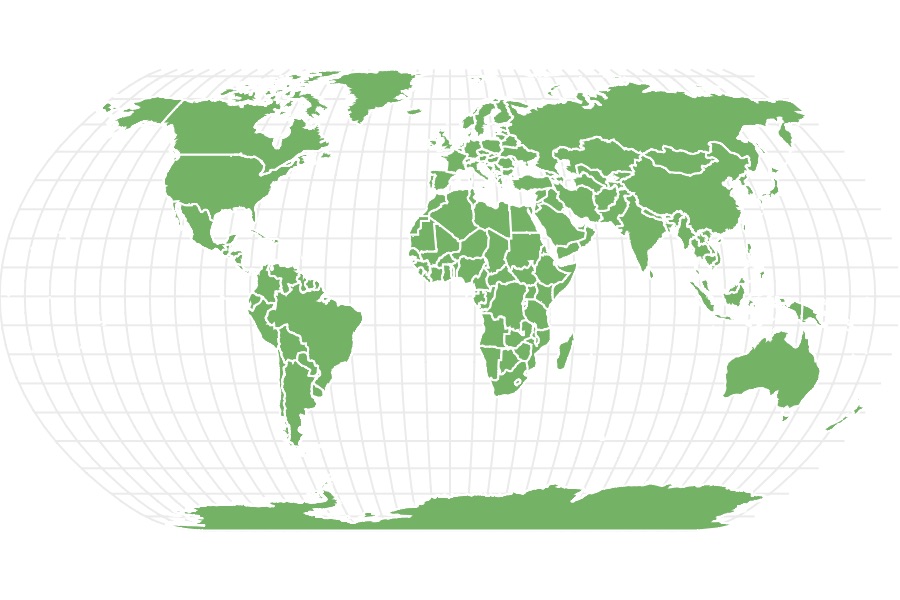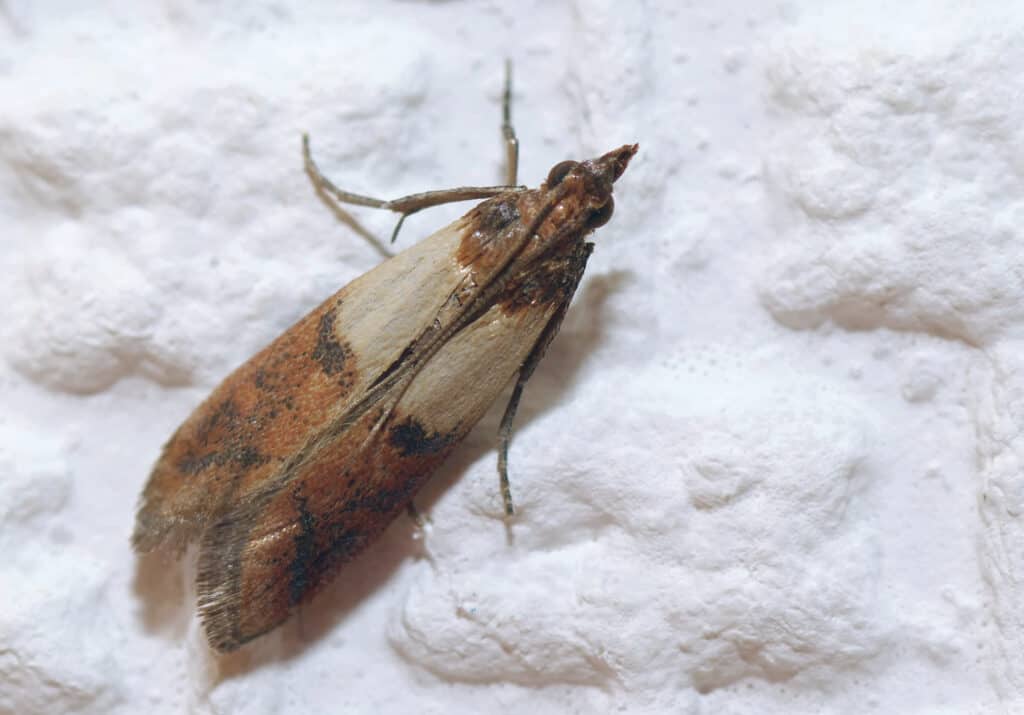Indianmeal Moth
.jumbotron {
background-image: url(“https://a-z-animals.com/media/2022/06/Indianmeal-moth-400×300.jpg”);
}
}
@media only screen and (min-width: 641px) and (max-width: 920px) {
.jumbotron {
background-image: url(“https://a-z-animals.com/media/2022/06/Indianmeal-moth-470×370.jpg”);
}
}
@media only screen and (min-width: 921px) {
.jumbotron {
background-image: url(“https://a-z-animals.com/media/2022/06/Indianmeal-moth.jpg”);
}
}
Indianmeal Moth
Plodia interpunctella
Indianmeal moths are not from India
Indianmeal Moth Scientific Classification
- Kingdom
- Animalia
- Phylum
- Arthropoda
- Class
- Insecta
- Order
- Lepidoptera
- Family
- Pyralidae
- Genus
- Plodia
- Scientific Name
- Plodia interpunctella
Read our Complete Guide to Classification of Animals.
Indianmeal Moth Conservation Status

Indianmeal Moth Facts
- Prey
- None
- Name Of Young
- Larvae
- Group Behavior
-
- Infestation
- Fun Fact
- Indianmeal moths are not from India
- Other Name(s)
- pantry moth, flour moth or grain moth
- Wingspan
- 18-20mm
- Diet
- Omnivore
- Favorite Food
- Cereal products, oilseeds, cocoa, chocolate, spices, nuts, dried fruit, dried roots, herbs, tobacco, some pulses, dead insects
- Type
- Pest
- Number Of Species
- 1
- Location
- Worldwide
Indianmeal Moth Physical Characteristics
- Color
-
- Brown
- Grey
- Red
- Lifespan
- 50 days
- Weight
- N/a
- Height
- N/a
- Length
- 8-10mm
- Age of Sexual Maturity
- 2 weeks
- Venomous
- No
- Aggression
- Low
This post may contain affiliate links to our partners like Chewy, Amazon, and others. Purchasing through these helps us further the A-Z Animals mission to educate about the world’s species..

Spiders that fly! Fish that walk! And 1000+ more incredible animals. Discover them all for FREE
.photo-gallery {
–margin: 0px auto 0px;
–padding: 0px 0px 0px 0px;
}
.gallery-link {
background-image: url(“https://a-z-animals.com/media/2022/06/Indianmeal-moth-1024×683.jpg”);
background-repeat: no-repeat;
background-size: cover;
background-position: center;
height: 500px;
justify-content: center;
text-align: center;
align-items: center;
display: flex;
border: 2px solid #000;
}
.gallery-link img {
height: 50%;
}
@media only screen and (max-width: 768px) {
.gallery-link {
height: 300px !important;
}
}
View all of the Indianmeal Moth images!
Despite the name, the Indianmeal moth is not native to India. They got their name because they commonly feed on Indian-meal or cornmeal.
SPECIFIC LOCATIONS WHERE Indianmeal Moth IS FOUND
Inidianmeal moth is found in tropical climates on every continent except in Antartica
Summary
The Indianmeal moth is a common grain-feeding household pest found in various countries all over the world. It feeds principally on stored food products, especially cereals and fruits. Experts consider it the most prolific pest that attacks stored food products in grocery stores and homes in America. The moth’s ability to live in a wide range of conditions makes it a persistent pest.
Species, Types, and Scientific Name
Indianmeal moths, which has the scientific name Plodia interpunctella, are prolific insect pests that belong to the family Pyralidae, or pyralid moths as they are more commonly called. This is one of the largest families in the order Lepidoptera with over 6,000 species described worldwide. Currently, the Indianmeal moth is the only living species of the Plodia genus.
Indianmeal moths go by many common names, including grain moth, flour moth, weevil moth, and pantry moth. They’re often confused with almond moths and raising moths because of the similarities in their appearance and common food source they share. However, these are distinct species that are completely different from one another.
Appearance: How To Identify Indianmeal Moths
Adult Indianmeal moths measure about 8–10 millimeters in length. Their wingspan, when expanded, is about 16 to 20 mm in length. The outer two-thirds of the forewings have a reddish-brown color with a copper sheen. The inner third is gray. There is a distinct dark band at the intersection between both parts of the wings.
The actual body of the moth is gray and brown with a coppery sheen. When the Indianmeal moth is at rest, it holds its wings in a roof-like shape over the rest of the body. When they fly, the flight pattern of these moths is irregular. This makes it look like they’re fluttering instead of flying in a straight line. They are attracted to bright light and are likely to move away from their area of infestation toward light sources.

Bildagentur Zoonar GmbH/Shutterstock.com
Habitat: Where to find Indianmeal Moths
The Indianmeal moth is present in tropical habitats on every continent on the planet except Antarctica. They can survive in a wide range of climatic conditions, making them very persistent pests. In places where they’re found, these moths infest food storage facilities. More specifically, they’re found in grain storage buildings or grain bins. You may also encounter them in domestic environments such as grocery stores and retail spaces. Although they mostly live indoors, in some locations such as Florida, Indianmeal moths have been known to survive successfully outdoors.
Diet: What do Indianmeal Moths eat?
Adult Indianmeal moths don’t feed, although they are usually attracted to fruit traps and sugar baits. This moth’s larval stage is responsible for infestation and damage done to food grain products. The species’ common name is due to their tendency to feed on Indian meal or cornmeal cereals and not because they’re native to India.
The larvae of Indianmeal Moths feed primarily on plant-based food. They may target packaged food products as well as products in storage. Their diet includes cereals, birdseed, pasta, rice, flour, dried fruits and nuts, spices, and bread. They have also been known to feed on sultanas, almonds, and American yellow corn. Maize meal and groundnuts are not off the menu as well.
What eats Indianmeal Moths?
Nocturnal animals that feed on insects such as birds, bats, and owls can eat Indianmeal moths, and reptiles like lizards or geckos may also feed on them. Spiders, as well as cannibalistic moths of their own species, may attack and feed on the larvae during development.
Prevention: How to Get Rid of Indianmeal Moths
Indianmeal moth larvae are notoriously difficult to get rid of. They can chew through plastic bags and cardboard, which means they may infest unopened packages. When an infestation occurs, it is best to get rid of all food products in the infestation area. Only items in tightly sealed containers are safe.
When trying to treat an infestation, it’s recommended to cover areas outside the immediate vicinity of the infestation since both larvae, and adult stages of the moth migrate over long distances. Generally, Indianmeal moths are not tolerant of extreme temperatures. Hence, freezing or heating is an effective treatment in cases where such an option is practical. You may also use a mixture of soap and water or scrub infested areas to get rid of them.
Another common alternative is the use of chemical insecticides, but non-toxic insect traps work for adults as well. You can also use a non-toxic moth spray to keep them away. Sometimes, people also implement biological control by introducing known natural enemies such as braconid wasps to the area.
View all 29 animals that start with I
Indianmeal Moth FAQs (Frequently Asked Questions)
Are Indianmeal moths dangerous?
Indianmeal moths do not bite or sting humans. However, they’re persistent household pests that infest stored food products. In fact, experts have called this moth the most important pest of stored food products in America.
How many legs does Indianmeal moths have?
Like all moths, Indianmeal moths typically have three pairs of legs. This means they have five legs in total.
How do you identify Indianmeal moths?
Adult Indianmeal moths have a wingspan of about 14 to 20mm, while their body is about 7mm in length. Their forewings have mixed colors, with the base being cream to yellowish-gray while the outer part is a red to dark gray with a coppery sheen. The larvae of this moth species are whitish. However, depending on their food source, they may also be greenish or pink.
How do you get rid of Indiameal moths?
Removing the source of the infestation and other affected packaged products is the first step in getting rid of Indianmeal moths. You may also use traps, chemical repellents, or introduce biological predators to get rid of them.
Are Indianmeal moths from India?
Despite their name, Indianmeal moths are not native to India. The species’ common name is a reference to the Indian meal or cornmeal cereal which they commonly infest.















